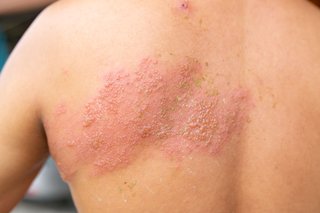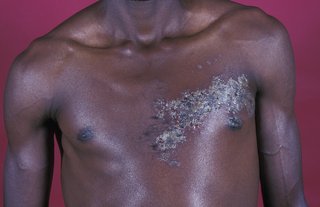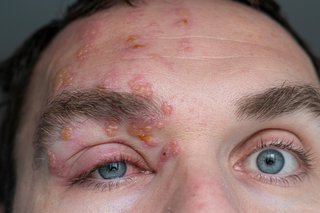Shingles is an infection that causes a painful rash. It is caused by the chickenpox (varicella zoster) virus.
Urgent advice: Ask for an urgent GP appointment if
you have the first signs of shingles, which include:
- tingling or painful feeling in an area of skin - especially if it is near or around your eye
- headache or feeling generally unwell
A rash usually appears a few days after the first signs.
Your GP may prescribe medicine to help speed up your recovery and avoid longer-lasting problems.
The medicine works best if you start taking it within 3 days of the shingles rash appearing.
Check if you have shingles
Usually you get shingles on your chest and tummy, but you can also get them on your face, eyes and genitals.
The rash appears as red blotches on your skin, on 1 side of your body only. A rash on both the left and right of your body is unlikely to be shingles.




Urgent advice: Contact your GP, GP out of hours or emergency department (ED) immediately if:
- you develop shingles around your eyes
You need urgent medical attention.
Treatment for shingles
Treatment for shingles depends on:
- how bad your symptoms are - you may not need any treatment if you have a mild rash
- whether you're at risk of complications
Your GP may prescribe antiviral tablets if:
- you have a weakened immune system
- your pain or rash is moderate or severe
- the rash is affecting other areas of your body apart from your chest, tummy and back
For the antiviral medicine to work properly, you usually need to take it within 3 days of the rash appearing.
You may can also need medicine such as:
- painkillers - for skin, muscle or nerve pain
- steroid tablets
What you can do to ease symptoms
There are things you can do to help ease shingles.
Do
-
take paracetamol to ease the pain
-
keep the rash clean and dry to reduce the risk of infection
-
wear loose-fitting clothing
-
hold a cool compress (a bag of frozen vegetables wrapped in a towel or a wet cloth) to the rash a few times a day
Don't
-
do not let dressings or plasters stick to the rash
-
do not wear clothes that irritate your skin
-
do not use antibiotic cream - this can slow healing
How long shingles lasts
It can take up to 4 weeks for the rash to heal.
Your skin can be painful for weeks after the rash has gone, but it usually gets better over time.
How to stop the virus spreading
You cannot spread shingles to others. But people who have never had chickenpox can catch chickenpox from you.
Try to avoid being in contact with:
- pregnant women who have never had chickenpox
- people with a weakened immune system - such as someone having chemotherapy
- babies less than 1 month old - unless it's your own baby, who should be protected by antibodies passed from you to them
Do not go to work or school if the rash is still oozing fluid (weeping) and cannot be covered, or until the rash has dried out.
You can only infect other people with the virus while the rash oozes fluid.
You can cover the rash with loose clothing or a non-sticky dressing.
Complications of shingles
Most people recover from shingles without any problems.
But it can cause complications, such as:
- post-herpetic neuralgia - this is where pain lasts for months after the shingles rash has gone
- the rash gets infected - you may need antibiotics
- scarring or changes in skin colour after the rash has healed
- muscle weakness
- eye problems - these can lead to sight loss
- Ramsay Hunt syndrome - this is a rare condition where shingles causes weakness on 1 side of your face and sometimes hearing problems
You can reduce your risk of complications by getting treatment as soon as possible after your symptoms start.
Shingles and pregnancy
If you're pregnant and get shingles, there's no danger to your pregnancy or baby. But your GP will probably refer you to a specialist, as you may need antiviral treatment.
Shingles and chickenpox
You cannot get shingles from someone with shingles or chickenpox.
But you can get chickenpox from someone with shingles, if you have not had chickenpox before.
When you get chickenpox, the virus remains in your body. It can be reactivated later and cause shingles. This usually happens if your immune system is weakened.
Your immune system may be weak due to stress, certain health conditions, or treatments such as chemotherapy.
Chickenpox symptoms and treatment
Shingles vaccination
You can get a vaccine against shingles. It is only available privately, so you have to pay to get it. You cannot get it through your medical card or drug payment scheme.
Talk to your GP if you want more information about the vaccine.
Content supplied by the NHS and adapted for Ireland by the HSE
